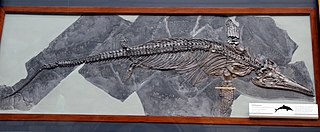
Ichthyosaurus is a genus of ichthyosaurs from the late Triassic and early Jurassic of Europe and Asia (Indonesia). It is among the best known ichthyosaur genera, as it is the type genus of the order Ichthyosauria.
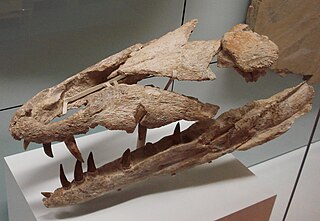
Dakosaurus is an extinct genus of crocodylomorph within the family Metriorhynchidae that lived during the Late Jurassic and Early Cretaceous. It was large, with teeth that were serrated and compressed lateromedially. The genus was established by Friedrich August von Quenstedt in 1856 for an isolated tooth named Geosaurus maximus by Theodor Plieninger in 1846. Dakosaurus was a carnivore that spent much, if not all, its life out at sea. The extent of its adaptation to a marine lifestyle means that it is most likely that it mated at sea, but since no eggs or nests have been discovered that have been referred to Dakosaurus, whether it gave birth to live young at sea like dolphins and ichthyosaurs or came ashore like turtles is not known. The name Dakosaurus means "biter lizard", and is derived from the Greek dakos ("biter") and σαῦρος -sauros ("lizard").

Temnodontosaurus is an extinct genus of ichthyosaur from the Early Jurassic period. It lived between 200 and 175 million years ago, and lived in what is now Europe and Chile. They lived in the deeper areas of the open ocean. University of Bristol paleontologist Jeremy Martin described the genus Temnodontosaurus as “one of the most ecologically disparate genera of ichthyosaurs”.

Stenopterygius is an extinct genus of thunnosaur ichthyosaur known from Europe. This genus of ichthyosaur grew to a maximum length of 4 meters.

Excalibosaurus is a monotypic genus of marine prehistoric reptiles (ichthyosaurs) that lived during the Sinemurian stage of the Early Jurassic period in what is now England. It is characterized by the extreme elongation of the rostrum, with the lower jaw about three-fourths of the length of the upper jaw, giving the animal a swordfish-like look. The only known species is Excalibosaurus costini.
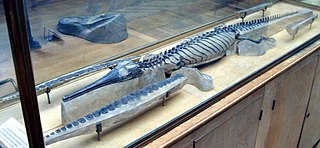
Pelagosaurus is an extinct genus of thalattosuchian crocodyliform that lived during the Toarcian stage of the Lower Jurassic, around 183 Ma to 176 Ma, in shallow epicontinental seas that covered much of what is now Western Europe. The systematic taxonomy of Pelagosaurus has been fiercely disputed over the years, and was assigned to Thalattosuchia after its systematics within Teleosauridae were disputed. Pelagosaurus measured 3 m (10 ft) in length with a weight of 450 kg (1000 lbs), and was markedly similar to the modern-day gharial, which has similar adaptions and carnivorous feeding habits.

Palaeocoma d'Orbigny, 1850, is an extinct genus of brittle stars that lived during the Middle Triassic to Early Jurassic Periods. Its fossils have been found in Europe.

The Posidonia Shale geologically known as the Sachrang Formation, is an Early Jurassic (Toarcian) geological formation of southwestern and northeast Germany, northern Switzerland, northwestern Austria, southern Luxembourg and the Netherlands, including exceptionally well-preserved complete skeletons of fossil marine fish and reptiles. The Posidonienschiefer, as German paleontologists call it, takes its name from the ubiquitous fossils of the oyster-related bivalve Posidonia bronni that characterize the mollusk faunal component of the formation.
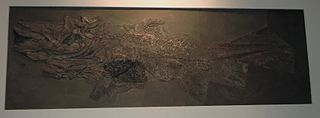
Trachymetopon is an extinct genus of prehistoric coelacanth from the Early Jurassic Posidonia Shale of Germany and the Middle Jurassic of France. Only one species has been named, Trachymetopon liassicum, described by Henning in 1951 from an almost complete specimen found in the Lower Toarcian of Ohmden in Baden-Württemberg. Another specimen is known from the same site, and two older specimens come from the Sinemurian of Holzmaden. The holotype of this species is 1.6 metres in length. A giant specimen of an undetermined species of Trachymetopon is known from the Middle Jurassic of Normandy. This specimen, composed of a 53 cm long palatoquadrate, belongs to an individual 4 metres (13 ft) in length. A study published in 2015 revealed that this coelacanth belongs to the Mawsoniidae. Trachymetopon is one of the few known mawsoniids to have been exclusively marine, while most of the other members of the group have lived in fresh and brackish waters.

Saurorhynchus is an extinct genus of carnivorous bony fish. It is the youngest representative of the family Saurichthyidae and the order Saurichthyiformes. This family is known for its large, elongate jaws, similar to modern Belonidae. Saurichthyidae also includes the Permian genus Eosaurichthys and the Triassic genus Saurichthys.

The Luxembourg Sandstone is a geologic formation in Luxembourg. It exists along the eastern margin of the Paris Basin. Sandstone units continuous with the Luxembourg Sandstone also occur in France. It is Early Jurassic in age. It predominantly outcrops in a belt extending through south-central Luxembourg. It up to 100 metres thick and predominantly consists of carbonaceous poorly cemented sandstone and sandy limestone

The Sachrang Formation or "Posidonienschiefer" Formation is a geological formation of southwestern Germany, northern Switzerland, northwestern Austria, southeast Luxembourg and the Netherlands, that spans about 3 million years during the Early Jurassic period. It is known for its detailed fossils, especially sea fauna, listed below. Composed mostly by black shale, the formation is a Lagerstätte, where fossils show exceptional preservation, with a thickness that varies from about 1 m to about 40 m on the Rhine level, being on the main quarry at Holzmaden between 5 and 14 m. Some of the preserved material has been transformed into fossil hydrocarbon Jet, specially wood remains, used for jewelry. The exceptional preservation seen on the Posidonia Shale has been studied since the late 1800s, finding that a cocktail of chemical and environmental factors let to such an impressive conservation of the marine fauna. The most common theory is the changes on the oxygen level, where the different anoxic events of the Toarcian left oxygen-depleted bottom waters, with the biota dying and falling to the bottom without any predator able to eat the dead bodies.
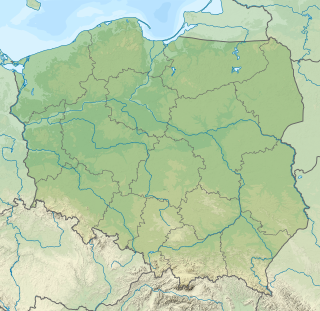
The Ciechocinek Formation, formerly known in Germany as the Green Series is a Jurassic geologic formation that extends across the Baltic coast, from Grimmen, Germany, to Nida, Lithuania, with its major sequence on Poland and a few boreholes on Kaliningrad. Dinosaur remains are among the fossils that have been recovered from the formation, not yet been allocated to a specific genus. The layers assigned to the formation are a group of sediments that differ from the those of the Posidonia Shale and other Toarcian formations of Europe. Most of the sediments of the Polish realm come from deltaic, fluvial and marine deposits. In the Polish realm there is also an abundance of siderite, attributed to mixed saline and marine action, with the rounding off of some due to transport by freshwater or sea currents. Its main equivalents are the Posidonia Shale, upper part of the Rydeback Member, Rya Formation, the Fjerritslev Formation, the Bagå Formation (Bornholm) or the Lava Formation (Lithuania). There are also coeval abandoned informal units in Poland: Gryfice Beds, Lower Łysiec beds, or the "Estheria series".

The Ciechocinek Formation is a Jurassic geologic formation which extends across the Baltic coast from Grimmen, Germany, to Nida, Lithuania, with its major sequence in Poland and boreholes in Kaliningrad. Dinosaur species uncovered here, including Emausaurus and other unclassified genus.

The Saubach Formation is a geological formation in Austria and Germany, dating to about 180–174 million years ago. It was described originally as Saubachschichten in 1975, and classified as part of the Lower Jurassic Adnet Group.
Bdellodus is an extinct genus of hybodont shark from the Early Jurassic epoch of the Jurassic Period. The name roughly translates to "Leech Tooth." Friedrich August von Quenstadt named them this due to their "coal-black" color which he associated with leeches. It is monotypic, containing only the species B. bollensis. It is known from the Toarcian of Germany. It was named on an associated dentition. It is often placed in the subfamily Acrodontinae alongside other durophagous hybodontids.

Plagiophthalmosuchus is a genus of teleosauroid, known form the Early Jurassic Whitby Mudstone Formation of Whitby, Yorkshire, UK, and Dudelange, Luxembourg. The type species, P. gracilirostris, was originally named as a species of Teleosaurus in 1836, but then it was moved to Steneosaurus in 1961, but it was again moved to its own genus in 2020.
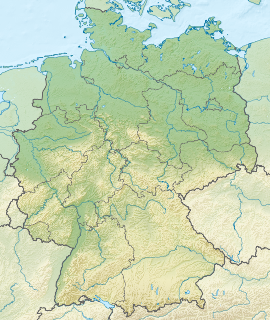
The Dactyliocerassandstein Formation is a Lower Jurassic geologic formation primarily located in Bavaria, Germany. The Formation appears on places like Bruck in der Oberpfalz, the north-east of the Banz Abbey, Wittelshofen, Regensburg and Bodenwöhr. In the astly foreland it extends from the Kulmbach area via Bayreuth, Creussen, Hirschau and Amberg to Schwandorf. Its southernmost known occurrences seems to be Schwandorf himself and Haselbach, although is also found at Bachhausen, far at the south. Is composed mostly by clusters of clay sandstone and sand-lime stone facies occurs only in the south-east of the northern Bavarian Jura region, for example at the edge of the granite Bavarian forest. On its northern edge, it is noticeably less tectonically disturbed in the Bodenwoehr basin near Sollbach. On the western edge it only appears on the Keilberg and Irlbach . It is a deposit recovered It is the same age as the marine Posidonia Shale, and has been identified as part of it in many sources. The formal relationship between the two layers, however, is undefined; the Posidonia Shale is sometimes described as a different coeval unit or a changed sector, possibly with more terrestrial influence. The extent of the major outcrop of the formation is not clearly delimited. It has been observed in Straßkirchen, Bogen, Straubing; its westernmost points are in Pfatter and a deep outcrop in Keilberg. The name of the Formation derives from the presence of Dactylioceras commune and annulatum, as part of the Monotis-Dactylioceras Bed present along the Lower Toarcian deposits on Bavaria. This Dactylioceras bank was recognized as the facies of the peel-poor bank, and was not destroyed in the Bifrons regression, hence the acummulation of Ammonites and the name of the layer. Is even preserved in the coastal area of the sand deposit, when the regression probably increased the transportability of the water so large that the thin, light Pseudomonotis (=Arctotis) shells were moved, but not the heavy ones, which at that time already contained sands filled of Dactylioceras specimens.
Fulgoridiidae are an extinct family of Jurassic planthoppers. They are the earliest group of planthoppers known, and appear to be a paraphyletic assemblage ancestral to living planthoppers. All currently known species are from Eurasia.
Rhomphaiodon is an extinct genus of prehistoric sharks in the order Synechodontiformes that has been found in Late Triassic and Early Jurassic deposits located in Europe. The type species R. minor was originally named as a species of Hybodus in 1837 by Louis Agassiz. A second species, R. nicolensis, was added when the genus was named in 1993.





















